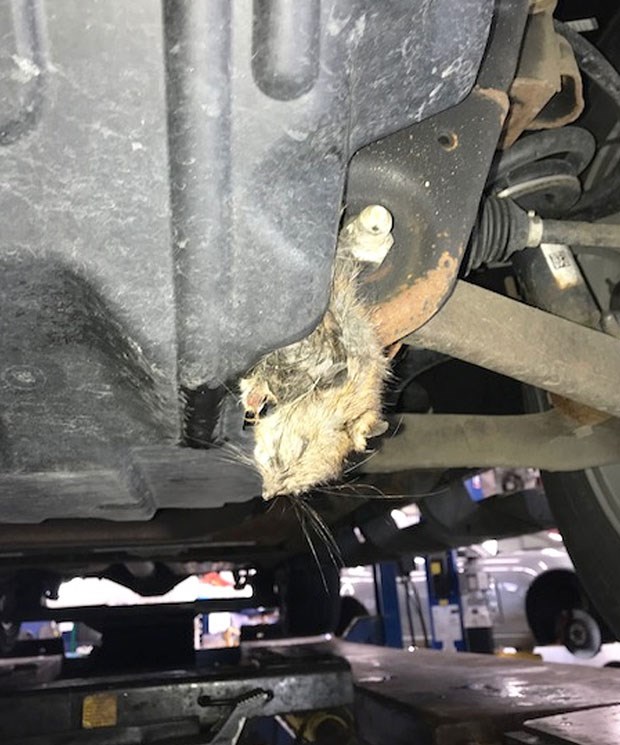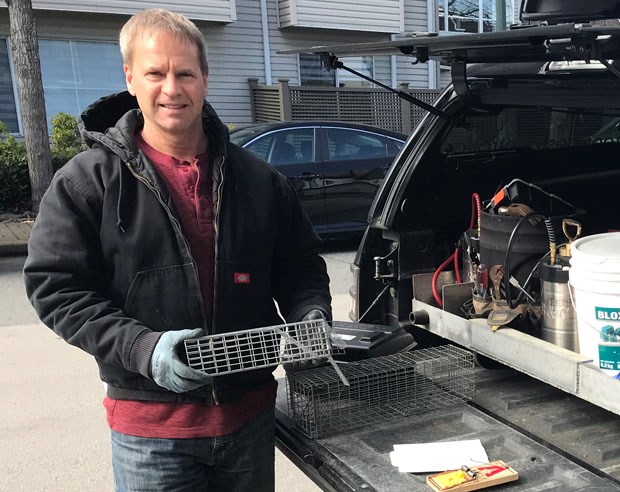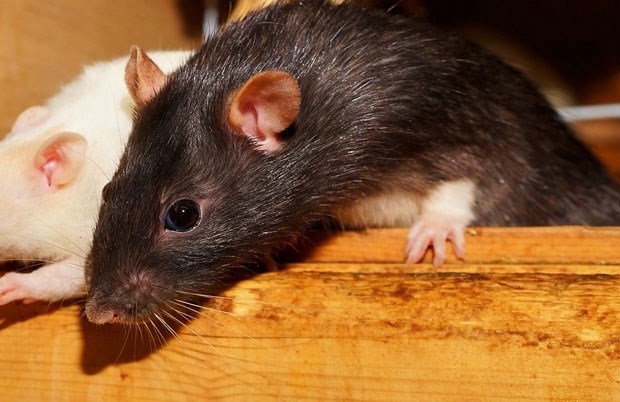(Above photo by Jared Belson)
The sight or sound of them scurrying about, especially inside homes, is enough to send a shiver down most people’s spines.
Wherever you have people, there are always going to be rats, sometimes lots of them, and here in Delta there seems to be more lately.
That’s what South Delta-based Go Green Pest Control owner Randy Bilesky has observed over the past few years, saying factors such as climate change and rodents being displaced due to development are resulting in a sharp increase in his call volumes.
“From my perspective, it’s getting worse every year. Hotter, drier summers are good for the rodents, for the rats, and the biggest thing I’ve found is a lot of land has been cleared and all the raptors have taken off. You see a lot of them at the dump area now, while rats are heading into Ladner and Tsawwassen, into the city,” said Bilesky.
He said he did about 250 rat jobs in the area last year.
“Rats are nocturnal, so they are typically going into the house or underneath at nighttime and that’s when people hear that scurrying, that scratching noise. It doesn’t matter if it’s a Norway rat or roof rat, they all like being in the roof because it’s got insulation, it’s warm and it’s secure.”
John McCafferty, who owns John's Thistle Auto on Elliott Street in Ladner, said he sees countless vehicles that show evidence of the rodents scurrying around under engine hoods looking for a warn place, particularly in the colder months. It can range from little footprints and droppings, chewed wiring to full nests. The damage can run into the thousands.

“If your car sits in the same place for days, it’s a perfect place for them to go and be undisturbed,” he said. “A truck that we had in recently even had a live rat in it.”
McCafferty said cotton balls laced with mint extract can be a good preventative measure.
Metro Vancouver doesn’t have a coordinated program when it comes to rats, leaving individual municipalities to deal with them.
The problem has reportedly been so pronounced in the City of Vancouver that the Vancouver Rat Project was initiated.
In Delta, however, there’s no special campaign targeting rats. Mike Brotherston, Delta’s manager of climate action and environment, said based on calls from the public, the problem doesn’t seem more pronounced.
“Two or three years ago we were up a bit and looked at what additional things we can do to reduce the problem in the community,” said Brotherston. “One new thing we implemented was applicants for demolition permits having to submit a form signed off by a pest control company, basically to attest that it’s rodent free. We would see in some cases abandoned houses that tended to be great habitat for rats. That certainly helped bring back down the number of neighbourhood calls.
“Certainly, when we get calls, sometimes it’s clearly an unsightly property or bylaw call like open garbage or things attracting rats onto a property. Sometimes it’s just an education thing and we’ll send out information to a neighbourhood on what they can do, because sometimes they aren’t always aware of the things that are attracting rats to a neighbourhood, things like fruit droppings from trees in the fall. There’s also feeding pets outside, bird feeders, open compost. Sometimes it’s a seasonal thing we see.”
Orkin Canada this week released its annual list of B.C.’s “rattiest” cities which saw Delta ranked 11th, up one spot from the previous year. The rankings are established by the number of treatments the pest control company performs in the prior calendar year.
Bilesky has a lengthy checklist of what homeowners can do to discourage rats, which can not only climb but have an uncanny ability of squeezing into small spaces, from making their way inside. He suggests pruning trees or shrubs near the side of homes as branches can act as an escalator for rats that love attics and crawlspaces.

Also, the disease-carrying rodents can scale brick chimneys, while gaps between soffits and rooflines can be an open invitation as well.
On the ground level, galvanized mesh, as long as it’s the proper size, can be effective around the foundation. Leaving piles of wood, especially right next to a house, and having bird feeders can also attract the unwanted pests.
A few of the other recommendations when it comes to rats include storing compost kitchen waste only in sturdy, closed bins and not putting meat scraps or bones in the bins, storing outdoor garbage in tightly-closed containers, making sure that bird feeders are away from buildings and seeds don’t spill on the ground, and repairing any leaky plumbing.
The province’s Environment and Climate Change Strategy notes rats have been present in B.C. since the mid- to late-1800s. They are well established, particularly in the Lower Mainland, Vancouver Island and Gulf Islands, but are also present in other areas.
Due to B.C.’s milder climate, rats have spread and become established in forested and agricultural areas. Rat numbers vary from year-to-year depending on local conditions.
The Ministry of Environment recommends several options for rat control, including setting snap traps or using live traps if other native wildlife may be present. The province suggests professional pest controllers might be the best option for serious rat infestations or for long-term control.
For more information, go to http://www2.gov.bc.ca/gov/content/environment/pesticides-pest-management/managing-pests/animals/rodents.
The province also welcomes reports from the public on the location of rats and other invasive species. There are a number of ways to report invasive species, including smartphone apps and an online reporting form. For more information, visit http://www.gov.bc.ca/invasive-species.



